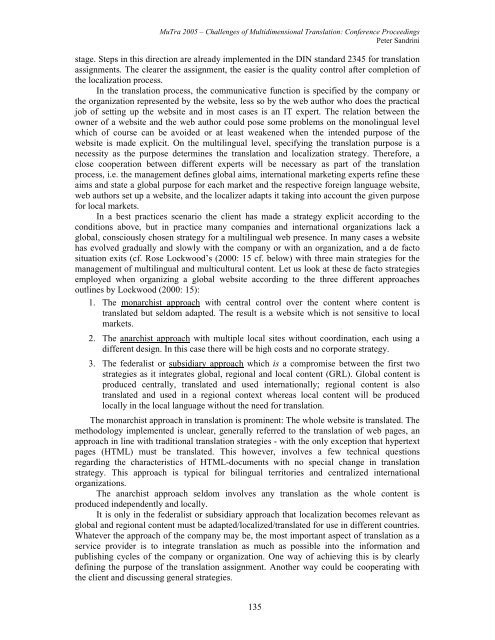Proceedings - Translation Concepts
Proceedings - Translation Concepts
Proceedings - Translation Concepts
Create successful ePaper yourself
Turn your PDF publications into a flip-book with our unique Google optimized e-Paper software.
MuTra 2005 – Challenges of Multidimensional <strong>Translation</strong>: Conference <strong>Proceedings</strong><br />
Peter Sandrini<br />
stage. Steps in this direction are already implemented in the DIN standard 2345 for translation<br />
assignments. The clearer the assignment, the easier is the quality control after completion of<br />
the localization process.<br />
In the translation process, the communicative function is specified by the company or<br />
the organization represented by the website, less so by the web author who does the practical<br />
job of setting up the website and in most cases is an IT expert. The relation between the<br />
owner of a website and the web author could pose some problems on the monolingual level<br />
which of course can be avoided or at least weakened when the intended purpose of the<br />
website is made explicit. On the multilingual level, specifying the translation purpose is a<br />
necessity as the purpose determines the translation and localization strategy. Therefore, a<br />
close cooperation between different experts will be necessary as part of the translation<br />
process, i.e. the management defines global aims, international marketing experts refine these<br />
aims and state a global purpose for each market and the respective foreign language website,<br />
web authors set up a website, and the localizer adapts it taking into account the given purpose<br />
for local markets.<br />
In a best practices scenario the client has made a strategy explicit according to the<br />
conditions above, but in practice many companies and international organizations lack a<br />
global, consciously chosen strategy for a multilingual web presence. In many cases a website<br />
has evolved gradually and slowly with the company or with an organization, and a de facto<br />
situation exits (cf. Rose Lockwood’s (2000: 15 cf. below) with three main strategies for the<br />
management of multilingual and multicultural content. Let us look at these de facto strategies<br />
employed when organizing a global website according to the three different approaches<br />
outlines by Lockwood (2000: 15):<br />
1. The monarchist approach with central control over the content where content is<br />
translated but seldom adapted. The result is a website which is not sensitive to local<br />
markets.<br />
2. The anarchist approach with multiple local sites without coordination, each using a<br />
different design. In this case there will be high costs and no corporate strategy.<br />
3. The federalist or subsidiary approach which is a compromise between the first two<br />
strategies as it integrates global, regional and local content (GRL). Global content is<br />
produced centrally, translated and used internationally; regional content is also<br />
translated and used in a regional context whereas local content will be produced<br />
locally in the local language without the need for translation.<br />
The monarchist approach in translation is prominent: The whole website is translated. The<br />
methodology implemented is unclear, generally referred to the translation of web pages, an<br />
approach in line with traditional translation strategies - with the only exception that hypertext<br />
pages (HTML) must be translated. This however, involves a few technical questions<br />
regarding the characteristics of HTML-documents with no special change in translation<br />
strategy. This approach is typical for bilingual territories and centralized international<br />
organizations.<br />
The anarchist approach seldom involves any translation as the whole content is<br />
produced independently and locally.<br />
It is only in the federalist or subsidiary approach that localization becomes relevant as<br />
global and regional content must be adapted/localized/translated for use in different countries.<br />
Whatever the approach of the company may be, the most important aspect of translation as a<br />
service provider is to integrate translation as much as possible into the information and<br />
publishing cycles of the company or organization. One way of achieving this is by clearly<br />
defining the purpose of the translation assignment. Another way could be cooperating with<br />
the client and discussing general strategies.<br />
135
















